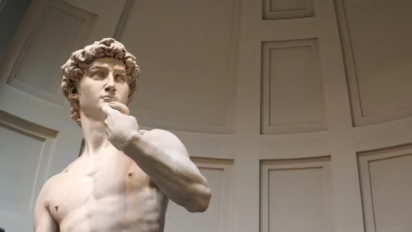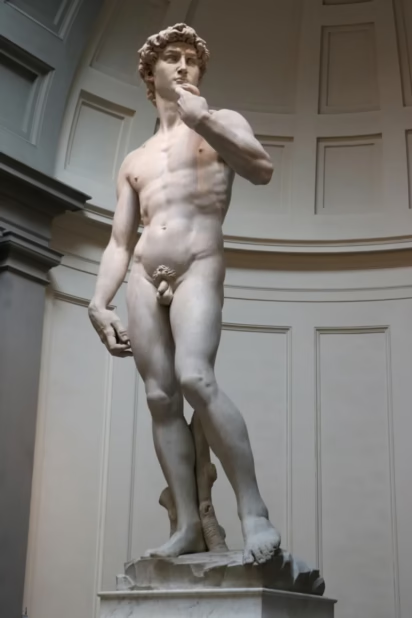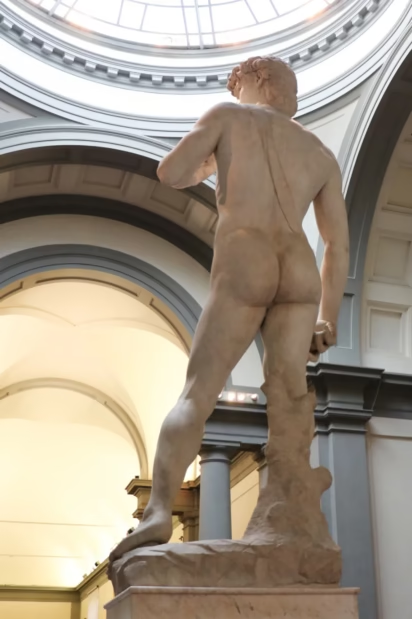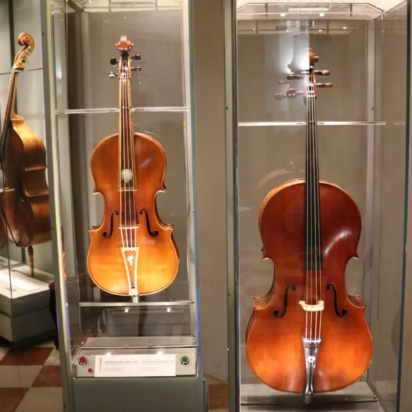See Michelangelo’s David, the world’s most famous statue on display in the Galleria dell’ Accademia di Firenze in Florence, Italy.

The large marble sculpture of David by Michelangelo is often described as the most famous statue in the world. David is displayed in the Accademia Gallery in Florence, where it is the most impressive work to see. The museum further has paintings from the pre-Renaissance period and also a collection of historical musical instruments. However, David is by far the star, and some say with some justification, the only highlight in this small museum. The only sensible way to visit the Accademia is with online time-slot reservation tickets or on a guided tour, which is a good option for easy admission and to focus on the main works on display. Book early — tickets sell out weeks in advance in peak periods.
→ Top museums, churches, and sights in Florence are open mostly as normal in 2025 — see 2025: Florence Opening Hours of Top Sights, Museums, and Churches for the latest information and opening hours. The Firenzecard is again sold while the Turbopass Florence City Pass is a good alternative that includes online timeslot reservations for both the Uffizi and Accademia.
See Michelangelo’s David in Florence
Although the Accademia in Florence may be seen without advance bookings, time-slot reservations for a visit on any day remain very sensible and money well spent. In busy periods, tickets sell out weeks in advance. Buy tickets online with timeslot reservations for skip-the-line access.
Renovations of the Galleria dell’Accademia in Florence continue. The small musical instruments museum will be renovated and may be closed for much of 2025. If open, visit it first — to the right upon entry — to avoid the need to backtrack.
A one-way system is in place during busy periods. As before, the toilets are only accessible on the way out. Few would regret going elsewhere (ditto for WCs in the Uffizi).
→ See Buy Skip-the-Line Tickets for the Accademia to See David in Florence for visitor information and opening hours.
Galleria dell’ Accademia di Firenze with Michelangelo’s David
The Galleria dell’ Accademia di Firenze (Gallery of the Academy in Florence) is world-famous for the David statue of Michelangelo, which is on permanent display under a glass cupola in the heart of the gallery. David is the top work to see here, and some would say the only piece worth the effort but that is unkind, yet understandable in a city with so many other fine museums, galleries, and art-filled churches.
Although many of the further works on display are very good quality, visitors who head quickly towards the exit after having seen David are not totally wrong, especially if that allows for more time in the Uffizi, the Palatine Museum, the Bargello (sculptures), San Marco (Fra Angelico), or any of the numerous churches with fantastic art in Florence, such as the Santa Maria Novella, Santa Croce, or San Lorenzo.
The permanent collection of the Galleria is displayed in a dozen of rooms and consists of:
- Historical Musical Instruments
- 13th and 14th-Century Paintings
- 15th-Century Paintings
- 16th-Century Paintings
- Sculptures
Layout of the Accademia in Florence
After entering the museum, the Sala del Colosso is directly in front and the musical instruments to the right. If open, see this small section first, then backtrack to the entrance.
To the left of the Sala del Colosso are the Michelangelo sculptures and paintings leading to the David sculpture. After David are more sculptures (of much lower quality) and paintings.
The paintings on the upper level are of excellent quality but most visitors are likely to enjoy the art more in the Uffizi or even the Fra Angelico paintings in the nearby San Marco. Most tour groups head straight for David and then exit, which leaves the rooms off the main route pleasantly quiet even on busy days.
Sala del Colosso in the Galleria dell’ Accademia
The hall of the Colossus was named after large sculptures no longer displayed here. However, at its center is a large raw clay model of Giambologna’s Rape of the Sabines. It was used to sculpt the marble placed in the Piazza della Signoria in 1582.
The paintings here are mostly from the 15th century and include works by among others Botticelli, Fra Bartolomeo, Filipino Lippi, and Ridolfo del Ghirlandaio. Many visitors find these the easiest paintings to enjoy in the gallery, but the room is often crowded and the works are not as impressive as those in the Uffizi.
Michelangelo Gallery of the Prisoners

The gallery leading from the entrance to the David sculpture has various names inspired by the six unfinished Michelangelo marble works on display here. The late 19th-century plans for a major Michelangelo museum failed despite securing the David statue.
The official name is the La galleria dei Prigioni (Gallery of the Prisoners) named after the four prisoners (sometimes also termed slaves) originally intended for the monumental tomb of Pope Julius II. As uncompleted works, the prisoners languished in the Boboli Gardens for centuries. They show how Michelangelo released the statues from the marble. In contrast to most sculptors, he chiseled the marble directly without making a clay model first. The two further incomplete Michelangelo works here are Matthew and the Pieta di Palestrina (which many considered not to be by the master at all).
Michelangelo’s David in the Accademia in Florence
David is at the far end of the gallery in a rotunda beautifully lit through a glass sky roof. David is easy to see from a distance, as he stands high up on a pedestal. A further glass wall protects him from touch and hammers. (The toes of his left foot were damaged by hammer blows in the 1990s.) Even on busy days, groups move on surprisingly fast making it easy to appreciate the work without phone screens in the way all the time.
Michelangelo’s David was originally commissioned for the buttresses of the Duomo — more or less above the current entrance for the cupola tours. However, upon completion of the work in 1504, with the support of among others, Leonardo da Vinci, Sandro Botticelli, Filippino Lippi, and the Perugino, it was rather placed at the entrance of Palazzo Vecchio.
David was moved to the Accademia only in 1872. A fine copy of David stands at its original position, where it may be seen for free at all hours. (A great savings option for those who could manage without seeing the original.)
As it was destined for the cathedral roof, Michelangelo’s David is big: 517 cm tall and weighing 5560 kilogram. For the same reason, his head is also slightly too big when seen only from this lower level.
Controversial David
It is easy to forget that rather than classical white marble, the true taste of early 16th-century Florence was what we now often consider kitsch — brightly painted maiolica and glazed terracotta, even if of the quality of the Robbias. Even David originally had some gilding, but being nude that was limited to a garland on his head, the sling, and the trunk supporting his right leg.
The sculpture was mostly admired, although some questioned the nudity for a biblical figure. Michelangelo took inspiration from the bronze nude David that Donatello produced in 1440. It is now in the Bargello (together with a marble almost Gothic young David that Donatello produced at the start of his career).
In contrast to the two Donatello sculptures, which show David after the fight with his foot resting on Goliath’s decapitated head (in exquisite detail, despite the gruesome event), Michelangelo’s David is preparing for battle with his sling in the left hand and swung over his shoulder and a stone in his right. Michelangelo’s David is also a bit older — David was a biblical youth but modern thinking varies his age at the time of the fight with Goliath as between 13 and mid-20s.
Apart from David, the best Michelangelo statues in Florence are in the Medici Chapels. The Bargello also has a few, while the Uffizi is home to the only surviving and completed easel painting by Michelangelo. Michelangelo’s best works are in the Vatican and Rome.
Gipsoteca (Plaster Casts Gallery)
The Galleria has a fine collection of plaster casts mostly by Lorenzo Bartolini (19th century). It follows shortly after the David statue, so many visitors wander into this hall, which gets a bit crowded as it is a dead-end.
Although the casts are of good quality and mostly used for the study of art, it is hard to get excited about plaster casts in a city full of marble originals. Many of the busts are of people famous during the period. The long list includes amongst others Franz Liszt, George Gordon Byron, Germaine de Stael, and several relatives of Napoleon. Other works are the exam pieces of local students.
Paintings in the Galleria dell’ Accademia

The Galleria has paintings by all major Florentine painters from the 13th to 16th centuries, thus from the Gothic to late Renaissance periods, but these struggle to compete with the works on display elsewhere in Florence.
The paintings are mostly of religious themes. Although of very good artistic quality they are not as easy to enjoy as the works in the Uffizi. Many visitors head straight for the exit after seeing David and pass by the Gothic and early Renaissance paintings. Even fewer visitors make it to the upper floor with mostly late 14th-century art, especially altarpieces.
Some of the top works include the Tree of Life (Pacino di Buanaguide), a few Giotto fragments, Scenes from the Lives of the Holy Hermits by Paolo Uccello, painted armoire doors from Santa Croce by Taddeo Gaddi, and several works by Barnardo Daddi and Lorenzo Monaco.
Historical Musical Instruments in the Accademia in Florence
The Musical Instruments Museum is a small but fine collection of nearly 50 instruments collected between the 17th and early 19th centuries. It includes instruments from the private collections of the grand dukes of Tuscany, the Medici and Lorena, and from the Conservatory Luigi Cherubini. Many of the instruments may be heard on multimedia stations.
The top items are string instruments, including a tenor viola and cello by Antonio Stradivari made in 1690 for the Grand Prince Ferdinando de Medici, a 1716 Stradivari violin, a 1650 Niccolò Amati cello, as well as an oval spinet and an ebony harpsichord created by Bartolomeo Cristofori. Several early pianos are also on display.
The musical instruments are on the ground floor away from the main museum and easily missed. (It may be closed for much of 2025 due to renovation work.)
→ See Buy Skip-the-Line Tickets for the Accademia to See David in Florence for visitor information and opening hours.
More Articles on Florence Sights
The high season in Florence is increasingly long: Easter, May, July, August, and the Christmas holidays are especially busy. November and January to mid-March are the only quiet months, except for the February school holiday week. Plan and book time-slot reservation tickets and tours when available in advance — the Accademia and the Uffizi are again sold out weeks in advance. Top sights are quieter directly at opening time or in the late afternoon.
→→ Opening hours for top sights in 2025 — most sights have long hours but advance time-slot reservations are always sensible.
- Tips on Buying Tickets for the Uffizi Museum
- Tips on Buying Skip-the-Line Tickets for the Accademia (Michelangelo’s David)
- See Michelangelo’s David in the Galleria dell’ Accademia
- Visit the Duomo sights: Cathedral (Duomo), Baptistery (Battistero), Bell Tower (Campanile), Dome (Cupola), Museum (Museo), and Tickets + Opening Hours
- Visit the Bargello Museum of Sculpture (Donatello’s Davids)
- Visit San Marco Museum to see the frescoes and altarpieces painted by Fra Angelico.
- Visit Santa Maria Novella Church and Museum to see medieval and Renaissance Art.
- Visit Santa Croce for Giotto Frescoes and Michelangelo’s Grave
- San Lorenzo complex: Visit the Basilica for Renaissance Art, See the Laurentian Medici Library by Michelangelo, and Visit the Medici Chapels (Michelangelo Statues)
- Visit the Orsanmichele Church and Museum with sculptures.
- Save on Sightseeing in Florence with the Firenze Card (again available but not including transportation or the Duomo sights, or consider the Turbopass Florence City Pass that includes online timeslot reservations for both the Uffizi and Accademia.
- Travel to Pisa to see the Field of Miracles and the Leaning Tower of Pisa.
- Visit the magnificent Romanesque-Gothic cathedral in nearby Siena.
- Save on top Italian designer fashion at The Mall Factory Outlet Stores.
Florence Resources
- The official website of the Firenze Tourist Office is a bit cumbersome but has very useful information. Especially the pdf (alternative link) with the opening hours of all major sights. Unfortunately, it is only available for the current month but it is the second last line on opening hours — the final say is the guard at the door, NOT the ticket window!
- Get Your Guide offers tours of all major sights while Tiqets sells online tickets for many top sights in Florence.
- Book luggage storage online and explore Florence more easily on foot.
- Trainline is good for booking online train tickets in Italy and most of Europe.







